Key takeaways:
- Grassroots networks thrive on personal connections and community engagement, fostering collective action through shared stories and experiences.
- Grassroots advocacy empowers individuals, creating a ripple effect that unites diverse voices and encourages ownership of local issues.
- Utilizing social media enhances outreach efforts and fosters collaboration, amplifying messages through personal narratives and visual storytelling.
- Adaptability and consistent communication are essential for sustaining grassroots efforts, helping to maintain motivation and strengthen relationships over time.
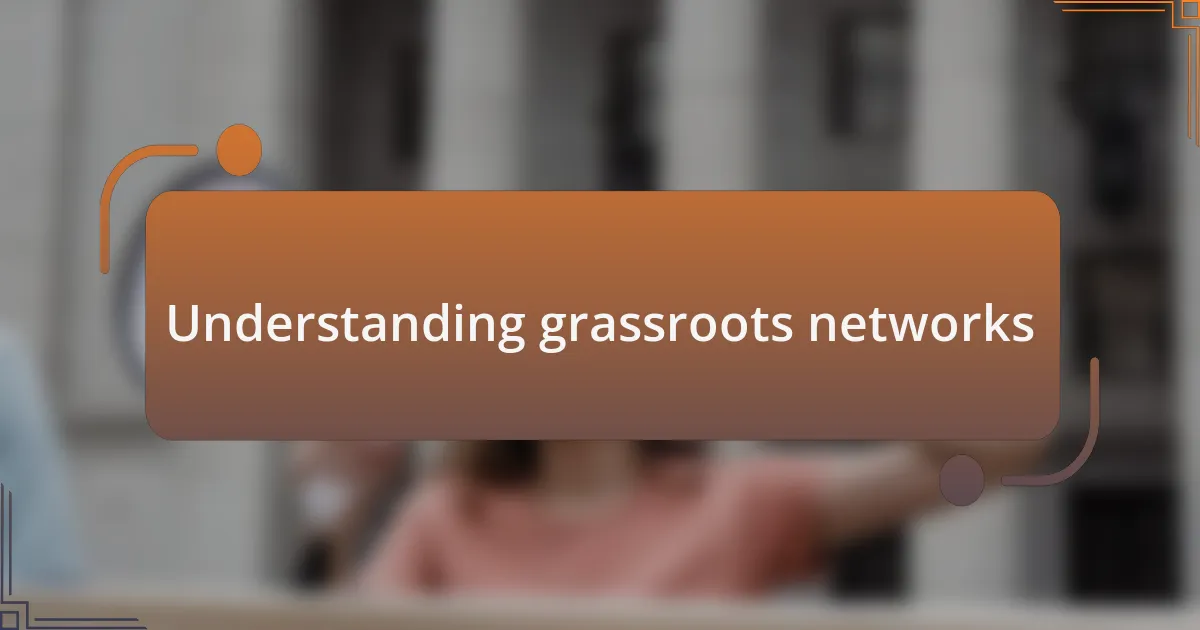
Understanding grassroots networks
When I first delved into grassroots networks, I found them to be a powerful way for everyday people to amplify their voices. It struck me that these networks are built on relationships, not just numbers; they thrive on genuine connections among individuals who share a common passion. Have you ever felt the spark of unity among like-minded individuals? That’s the essence of grassroots advocacy.
Grassroots networks operate on the principle that change begins at the community level. I vividly remember attending a small town meeting where locals shared their stories about their pro-life journeys. It was eye-opening to witness how personal experiences can translate into collective action. Each narrative added a unique thread to our cause, making our mission feel deeply relevant, grounded in the very fabric of our community.
The beauty of grassroots movements lies in their adaptability. I learned that by tapping into local issues and concerns, we can create a tailored message that resonates more profoundly with the audience. Have you considered how your community’s unique challenges could shape your advocacy efforts? Engaging directly with those concerns not only strengthens the network but also fosters a sense of ownership among members.
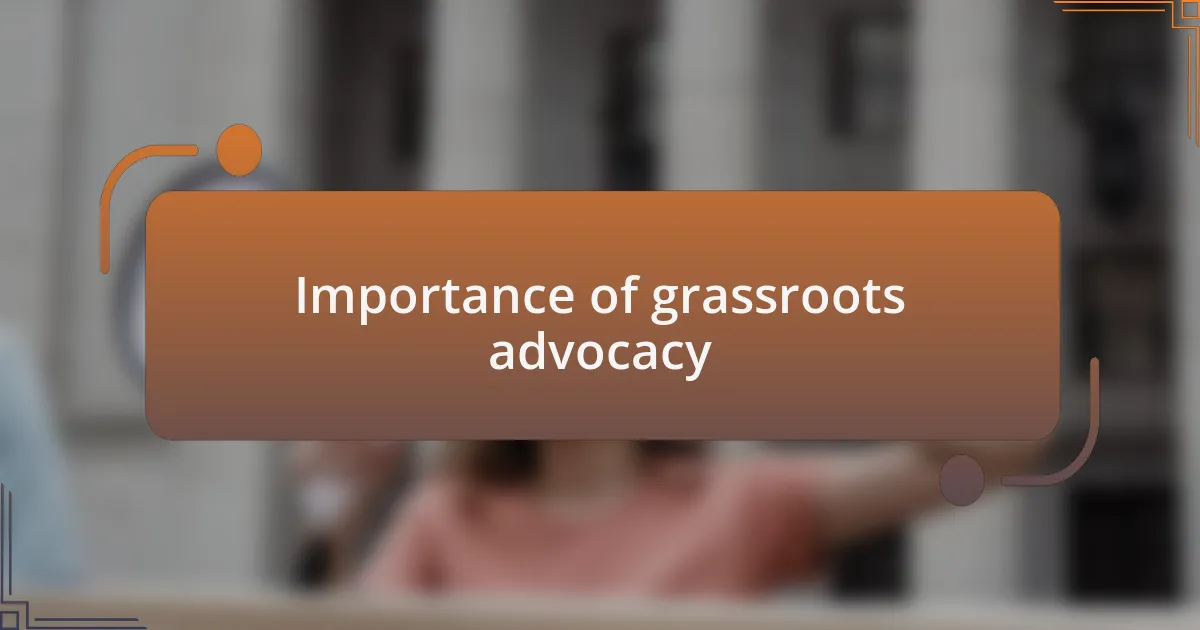
Importance of grassroots advocacy
Grassroots advocacy is essential because it empowers individuals to take ownership of issues that matter to them. I remember feeling profoundly moved when I first saw how passionate conversations in our community could lead to real legislative changes. When people connect their personal stories to wider societal issues, it creates a ripple effect that energizes and galvanizes others to join the cause. Have you experienced that moment when a shared story ignites a sense of purpose?
In my experience, grassroots advocacy also serves as a platform for diverse voices, adding depth and richness to our collective initiatives. I recall a time when a colleague shared her experience of facing an unplanned pregnancy. Her vulnerability opened the door for countless others to share their own stories, making our movement more relatable and inclusive. This diversity not only strengthens our message but also helps unite different perspectives under a common goal, fostering a supportive community where everyone’s experiences are valued.
Moreover, grassroots advocacy cultivates long-term relationships that outlast any single campaign. I’ve witnessed friendships form through shared actions, whether organizing events or participating in local discussions. These connections create a foundation for youth engagement and continuity, ensuring that our pro-life message remains alive and relevant in the face of changing societal attitudes. Have you thought about how building such a network can sustain your advocacy efforts? It’s fascinating how personal bonds can strengthen a movement, making it more resilient in the long run.
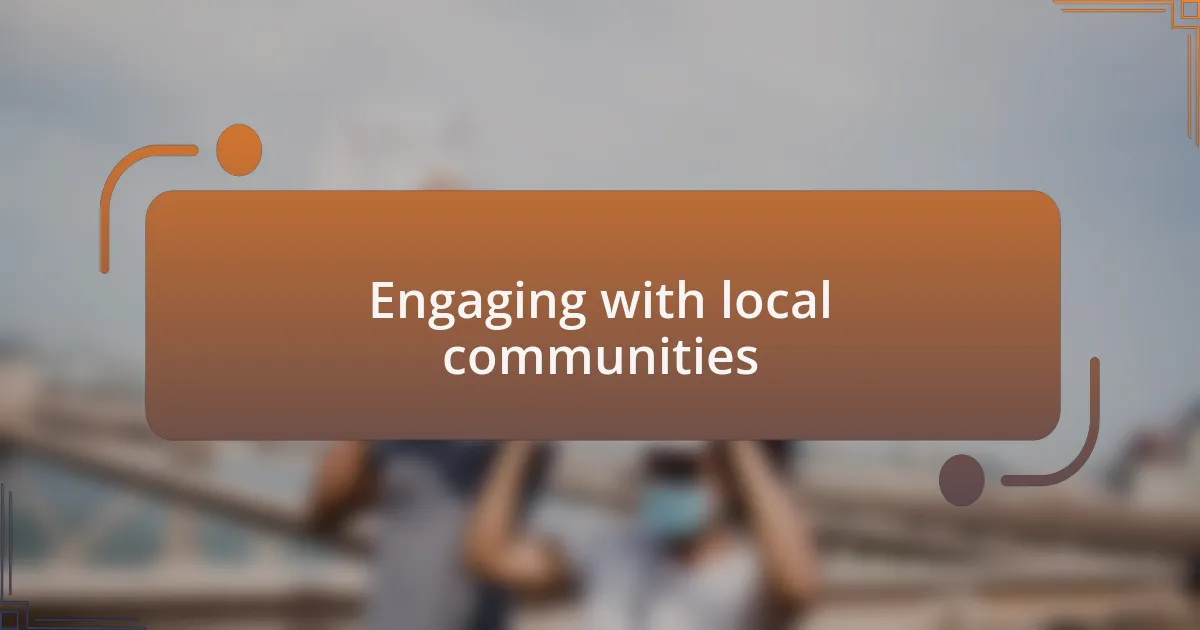
Engaging with local communities
The act of engaging with local communities is where the heart of grassroots advocacy beats strongest. I still remember walking into a local coffee shop, where I casually shared my thoughts about pro-life initiatives with a few patrons. What surprised me was how one conversation sparked others to join in, transforming a casual chat into a passionate dialogue. Isn’t it fascinating how often our most spontaneous interactions can lead to profound connections?
I’ve often found that hosting community events can be a game changer. Once, I organized a small neighborhood gathering focused on discussing local pro-life initiatives. The turnout was modest, yet the conversations were vibrant and meaningful. Hearing participants share their own experiences made me realize that advocacy thrives in authenticity. Have you ever felt the power of being part of a shared space where voices unite for a common cause?
Connecting personally with local leaders can amplify our efforts too. During a town hall meeting, I approached a local council member after his speech about family support services. I shared how our pro-life mission aligned with his community goals. That simple conversation led to a partnership that got our message into local newsletters. It reinforced my belief that building relationships is not just advantageous; it’s essential in driving real change. Do you see how these connections create opening doors that can transform advocacy into impactful action?
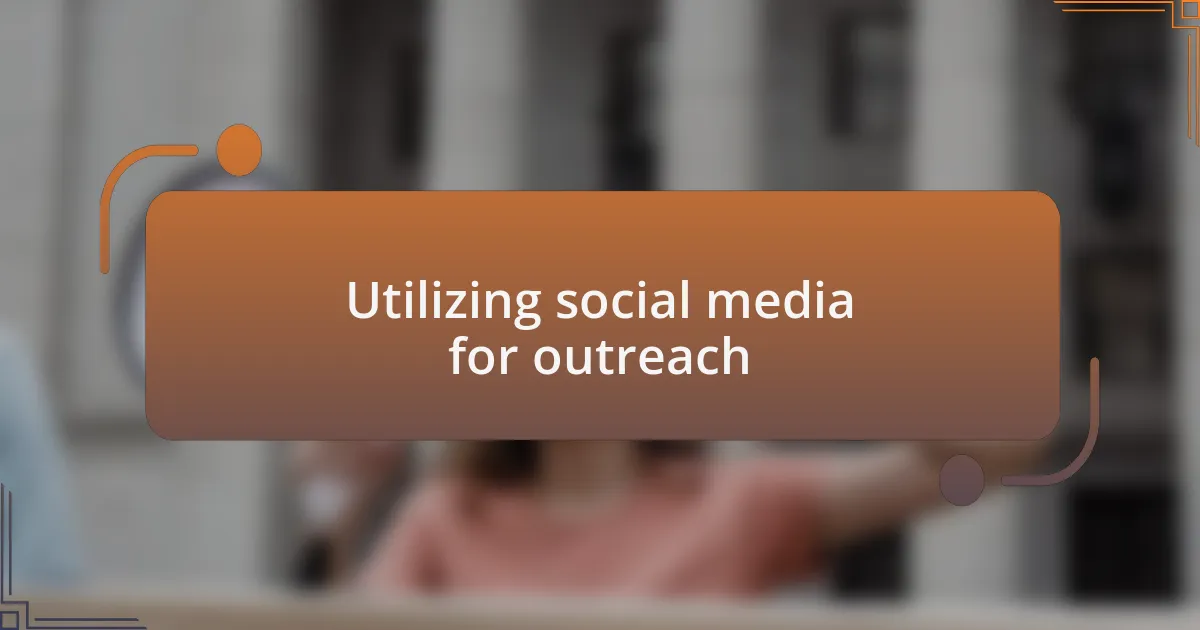
Utilizing social media for outreach
Social media is a powerful tool for grassroots outreach, and I’ve seen its potential firsthand. I remember when I first shared a personal story about my pro-life journey on Facebook. To my surprise, a wave of support flooded in, with friends and acquaintances sharing their own experiences. It was as if sharing my truth opened up a dialogue that had been waiting to happen. Don’t you find that the more we share our stories, the more we resonate with others?
On platforms like Instagram and Twitter, I’ve discovered that visuals can convey emotions more effectively than words alone. Once, I posted a simple graphic highlighting the statistics on adoption, accompanied by a heartfelt caption. The post garnered much attention, sparking discussions in the comment section. This engagement showed me that sometimes, a single image can help us reach hearts and minds far beyond our immediate circle. Have you ever considered how the right visual can help amplify your message?
Utilizing social media has also allowed me to connect with national pro-life organizations, fostering a sense of community and collaboration. I recall joining a Twitter chat organized by a prominent advocacy group. It was incredible to exchange ideas and strategies with passionate individuals from different regions. That experience reaffirmed my belief in the power of collective messaging. How do you think collaboration through social media can elevate our overall advocacy efforts?
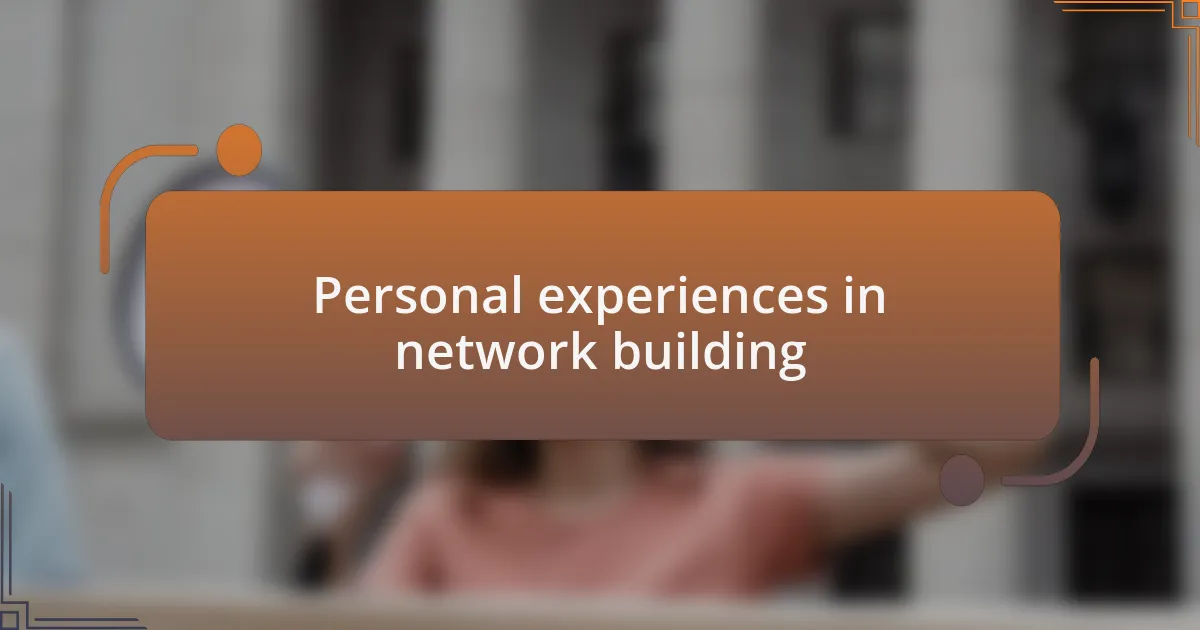
Personal experiences in network building
Building a grassroots network often feels like planting seeds in a garden. I vividly remember hosting my first local pro-life meet-up in a community center. I was nervous, but as people started arriving, their eager faces filled me with hope. It didn’t take long for us to realize that we all shared a common passion, leading to lively discussions that sparked ideas we had never considered before. Have you ever experienced that magic when strangers unite over a shared cause?
On another occasion, I partnered with a local church to organize a fundraising event for a pregnancy resource center. The collaboration was eye-opening; we tapped into each other’s networks and brought together diverse groups of people. Witnessing different generations connect over the cause was powerful. It reminded me that advocacy can bridge gaps, creating alliances I never expected. Can you think of partnerships in your own community that could strengthen your cause?
During these experiences, I learned that personal touch matters. Sending handwritten thank-you notes to participants really fostered deeper connections and encouraged them to stay engaged. It’s amazing how a small gesture can turn a one-time attendee into a lifelong advocate. How do you cultivate relationships with those who support your mission? Each interaction can be a building block for something greater.
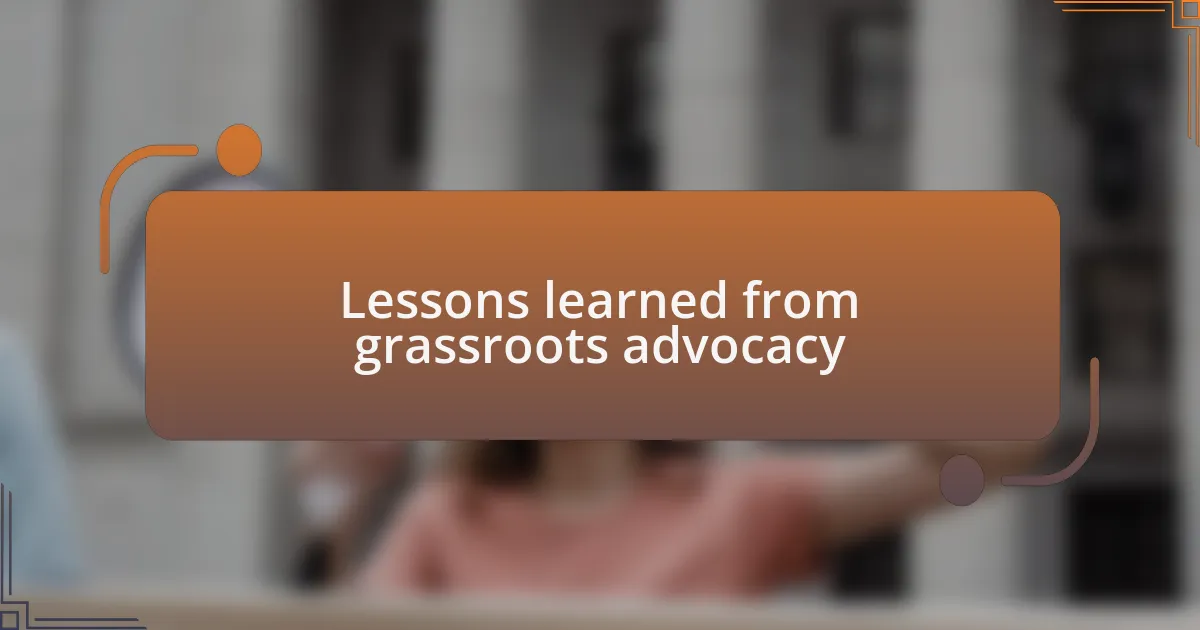
Lessons learned from grassroots advocacy
Grassroots advocacy teaches invaluable lessons about resilience and adaptability. I recall a time when a planned event faced unexpected rainstorms, threatening our turnout. Instead of seeing it as a setback, we quickly shifted to an online format, ultimately reaching an even broader audience. This experience reminded me that flexibility is key; sometimes, the best outcomes come from turning challenges into opportunities. Have you ever had to pivot like that and found success where you least expected it?
One of the most profound lessons I’ve learned is the importance of listening. During our grassroots gatherings, I made it a point to ask open-ended questions, allowing others to share their stories and perspectives. One participant shared a deeply personal journey that shifted my understanding of common issues in our advocacy. It struck me that everyone holds a unique narrative, and by valuing those stories, we not only enrich our mission but also strengthen empathy within our community. How often do we take the time to genuinely listen to those around us?
Building a grassroots network has also highlighted the power of consistent communication. After a campaign, I followed up with supporters through regular updates and newsletters. This not only kept our mission fresh in their minds but also ignited ongoing conversations. I learned that maintaining relationships is just as crucial as forming them. Have you reflected on how communication impacts your network? In my experience, it’s these consistent touchpoints that keep the momentum alive in advocacy.